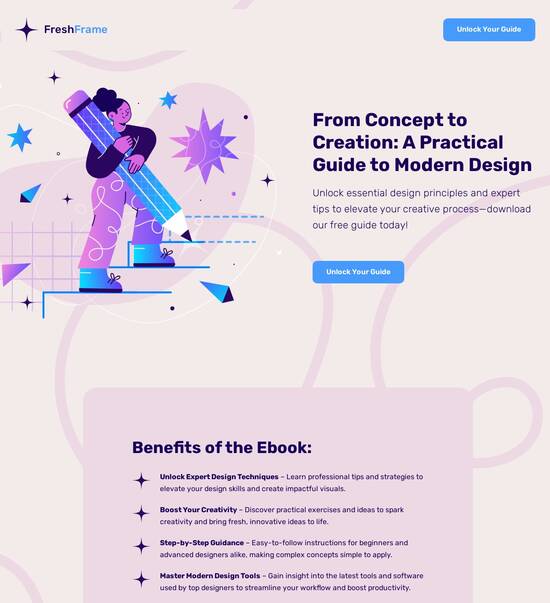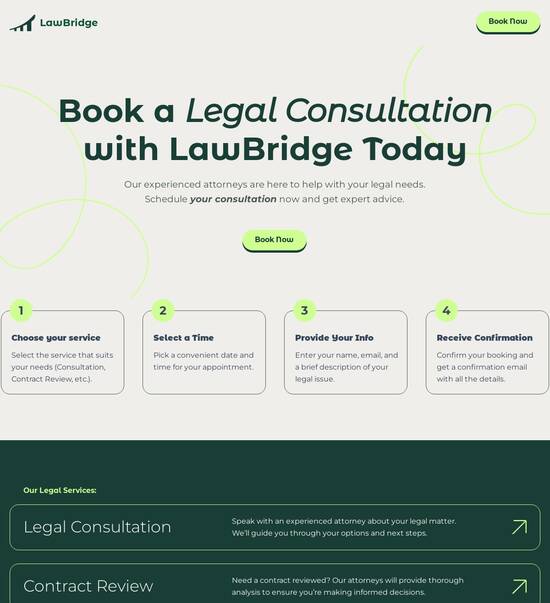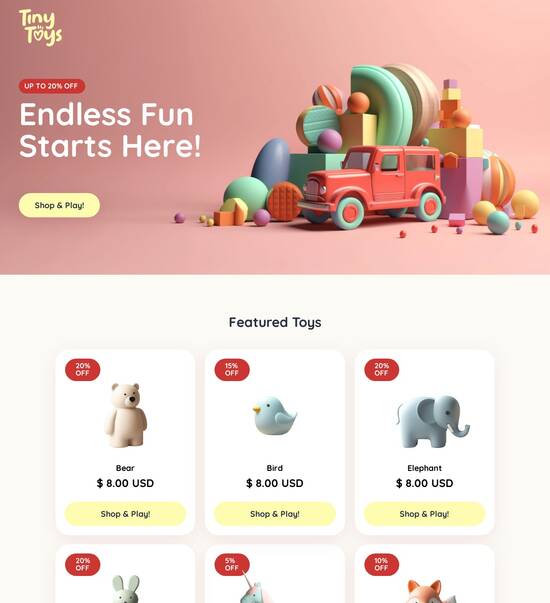
App page template for Food bloggers
Use TemplateAbout template
Attract clients and showcase your skills with style using our landing page templates for Food bloggers. Let's convert those visitors into clients!
Recommended templates

Easy to build without coding
With the intuitive drag-and-drop builder, anyone on your team can create high-converting pages without any knowledge of code or design. Make enhancements to your landing page with custom widgets using Javascript, HTML/CSS, or third-party scripts.

Multiple layouts for any industry and goal
Select from 500+ landing page layouts built to boost conversions across industry-specific scenarios. Customize them by adjusting fonts, adding images, and generating on-brand content with the AI assistant. Quickly scale with Instablocks® and Global Blocks that you can save, reuse, and update globally.

Loads fast and looks polished on any device
Every template is responsive, which means they present professionally on any device and load blazingly fast with our Thor Render Engine. You can also power them up with Google AMP technology to deliver an unparalleled mobile experience and drive higher conversions.

Robust analytics & experimentation
Get real-time updates and reporting across all your devices, showing the number of visitors, conversions, cost-per-visitor, and cost-per-lead. Launch AI-powered experiments, run A/B tests, and use heatmaps to analyze user behavior, then optimize your landing page to maximize conversions.







Easy to build without coding
With the intuitive drag-and-drop builder, anyone on your team can create high-converting pages without any knowledge of code or design. Make enhancements to your landing page with custom widgets using Javascript, HTML/CSS, or third-party scripts.
Multiple layouts for any industry and goal
Select from 500+ landing page layouts built to boost conversions across industry-specific scenarios. Customize them by adjusting fonts, adding images, and generating on-brand content with the AI assistant. Quickly scale with Instablocks® and Global Blocks that you can save, reuse, and update globally.
Loads fast and looks polished on any device
Every template is responsive, which means they present professionally on any device and load blazingly fast with our Thor Render Engine.
Robust analytics & experimentation
Get real-time updates and reporting across all your devices, showing the number of visitors, conversions, cost-per-visitor, and cost-per-lead. Launch AI-powered experiments, run A/B tests, and use heatmaps to analyze user behavior, then optimize your landing page to maximize conversions.
All the features you need to build lead-generating landing pages
Explore more featuresLearn how to build top-performing landing pages for any goal
FAQs
Leading the way in building high-performing landing pages





An <H2> main heading that incorporates the keyword step-by-step guide for Instapage
This step-by-step guide will help marketers optimize their digital campaigns using Instapage, the leading landing page and conversion rate optimization platform. By following each phase of this guide, you’ll learn how to harness Instapage to create high-converting landing pages that drive results and maximize ROI.
An key features of Instapage
Instapage is designed for marketers across various sectors, such as business services, education, and financial services. With its intuitive interface and abundant features, you can easily design landing pages, implement A/B testing, and personalize content for different audience segments.
- 100+ ready-to-use templates: These templates are tailored for various industries and can be customized to fit your branding. Instapage ensures that your pages are visually appealing and aligned with your marketing objectives.
- Built-in A/B testing: This feature allows you to create variations of your landing pages and test them against each other to identify which one performs better, thus enhancing your campaign's effectiveness.
- Analytics dashboard: Gain insights into visitor behavior and track essential metrics for further optimization, helping you refine your landing pages continuously.
An first step: Launch your landing page
To get started with Instapage, create an account and navigate to the template library. Here’s how to launch your first landing page with efficiency:
- Choose a template that aligns with your campaign goals. Instapage offers diverse options for different sectors, making it easier to find the right fit.
- Use the drag-and-drop builder to customize your selected template. Add elements such as images, forms, and buttons that resonate with your target audience.
- Preview your landing page to ensure everything looks perfect before publishing it to your domain.
An second step: Optimize for conversions
Once your landing page is live, focus on optimizing it for conversions with the built-in experimentation features to ensure you’re getting the best results.
- Use heatmaps to analyze user behavior. Understanding how visitors interact with your content will guide you in making essential adjustments.
- Conduct A/B tests to discover the most effective page elements, such as headlines and CTAs, to drive clicks and conversions.
- Utilize visitor metrics to tailor your content. Personalization increases engagement, so ensure that dynamic text replacement is adequately implemented.
An third step: Collaborate and iterate
Leverage Instapage's collaboration features to streamline your landing page production process. This approach helps gather feedback and implement changes more quickly.
- Invite team members to review pages, ensuring all stakeholders can provide input before going live.
- Make real-time edits based on the feedback received to enhance the quality and appeal of your landing pages.
- Share your landing pages with external stakeholders securely to facilitate transparency and gather diverse perspectives.
Implementing these steps will enhance your marketing strategies and significantly uplift the performance of your digital campaigns.
Ready to transform your landing page strategy? Sign up for Instapage today to discover how it can meet your unique marketing needs!
People also ask about App page template for Food bloggers
App page template for food bloggers
Understanding the landscape of food blogging
The world of food blogging has seen exponential growth over the years, fueled by the universal love for food and the desire to share culinary experiences. Influencers and home cooks alike use blogs as platforms to showcase recipes, cooking tips, and reviews of eateries. With stunning visuals and engaging content, food blogs offer a blend of creativity and practicality that resonates with diverse audiences.
However, food bloggers face several challenges in this crowded landscape. Common hurdles include identifying niche audiences to stand out, managing the volume and variety of content to keep readers engaged, and navigating the complexities of SEO to enhance visibility. Additionally, monetization remains a pressing concern, as bloggers often need to explore various strategies to turn their passion into a sustainable business.
A compelling app page template plays a crucial role in addressing these challenges. With the right design and structure, food bloggers can not only optimize their content for better visibility but also create an inviting experience that encourages user interaction and loyalty.
Core features of an app page template designed for food bloggers
At the heart of an effective food blog is a well-designed app page template that highlights recipes in an engaging way. A recipe showcase section is essential, allowing bloggers to display their culinary creations prominently. Offering various layout options, such as grid or list views, and the ability to filter recipes by cuisine, difficulty level, or dietary restrictions can significantly enhance user experience.
User-friendly navigation also enhances the overall experience. Intuitive categorization of content, complemented by a robust search feature, allows visitors to find their desired recipes quickly. An interactive comments section fosters community engagement, enabling users to share feedback and recipes, thus enriching the overall atmosphere of the blog.
Design elements that captivate and retain visitors
Visual appeal is paramount in food blogging. High-quality images are the first point of attraction for visitors. To optimize food photography, techniques such as good lighting, proper composition, and editing tools should be employed. Additionally, adhering to best practices for layout and choosing harmonious color schemes can help create a visually inviting blog.
Designing for mobile responsiveness is essential, as a significant portion of users access content via smartphones. Ensuring the layout adapts to various screen sizes while optimizing page speed can greatly improve user engagement. Moreover, maintaining branding consistency through logo designs, color palettes, and uniform fonts helps create a memorable identity, reinforcing brand loyalty.
Customizable components that enhance user experience
Flexibility in template design allows food bloggers to tailor their website to their unique style and voice. Options for layout adjustments—such as from grid to list views—enable bloggers to present their content in a manner that aligns with their personal branding. Personalized sections for unique content types, like video tutorials or cooking tips, can further enhance the user experience.
Integrating e-commerce features is another effective way to monetize content. Allowing users to purchase downloadable recipes or e-books directly through the blog can create an additional revenue stream. Moreover, incorporating affiliate marketing links in a natural, unintrusive manner ensures that bloggers can earn income while providing valuable resources to their readers.
Boosting traffic and engagement through optimized content
Optimizing for SEO is vital for increasing a food blog's visibility. Key on-page SEO features include well-written meta descriptions, use of header tags, and the strategic placement of keywords within recipe descriptions. Blogging consistently, while remaining mindful of current trends, ensures that content remains fresh and relevant.
Tools for content planning can help streamline the workflow of food bloggers. Scheduling posts and managing content effectively can prevent burnout and ensure a steady flow of high-quality material. Utilizing AI tools for generating ideas and optimizing existing content also helps bloggers stay ahead in a competitive environment.
Technical considerations for food bloggers using app page templates
Choosing the right web hosting service can have a significant impact on a food blog's performance. Factors such as uptime reliability, customer support, and scalability should be considered when selecting a provider. A well-performing site ensures faster loading times, which is crucial for retaining visitors.
Domain name best practices also play a critical role in brand recognition. A simple, memorable domain name that accurately represents the blog's theme can attract more visitors. Avoiding complex or lengthy names can help streamline the browsing experience and boost return traffic.
Analyzing success: metrics to track for continuous improvement
Regularly monitoring key performance indicators (KPIs) is essential for assessing the effectiveness of a food blog. Metrics such as visitor engagement, retention rates, and traffic sources provide valuable insights into reader behavior. Understanding user demographics allows bloggers to tailor content to better meet their audience's needs.
Feedback loops also play a pivotal role in continuous improvement. Listening to reader comments and adapting content based on their preferences helps maintain relevance. Regularly updating content ensures that the blog evolves with its audience, thus fostering loyalty and encouraging repeat visits.
Case studies: successful food blogs leveraging app page templates
Examining real-world examples of successful food blogs can provide valuable insights into best practices. Many bloggers succeed due to effective layouts that balance aesthetics and usability. They often employ various content types, including videos and interactive elements, to keep their audience invested.
Lessons learned from these case studies include the necessity of avoiding template pitfalls, such as overloading pages with content or neglecting mobile optimization. By observing trends and iterating their strategies, bloggers can refine their approach and improve engagement over time.
Ready to skyrocket conversions?
Supercharge your ad campaigns with high-performing landing pages
Get started














